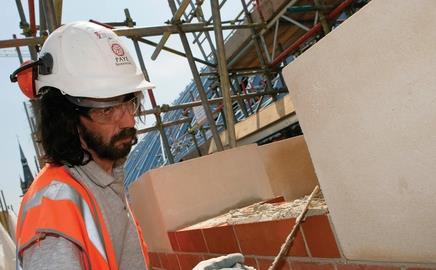Lime Technology was set up in 2002 as a spin-off from conservation specialist IJP Building Conservation.
Initially formed to supply hydraulic lime mortar, render and plaster products to large new-build developments, it has since branched out into making other lime-based products including Tradical hemp blocks, which are made of lime and hemp and lock in carbon dioxide.
It is now moving into the production of compressed earth blocks.
Based in Abingdon, Oxfordshire, the company employs 10 people and has an annual turnover of £1.5m. Ian Pritchett, managing director of Lime Technology talks about the changing demand.
What is the market like at the moment?
For us, it is sliced into three main sectors: people doing one-off houses, social housebuilders and mainstream housing developers, and large flagship developments. Most are one-off housebuilders, but there is a reasonable amount of social housing. Less from mainstream developers, but it’s filtering through.
Who specifies your products?
Mainly architects and clients.
Who are your main competitors?
We are competing with conventional building materials, so all brick, concrete blocks and traditional plaster makers. We are also competing with companies such as Hanson with our unfired earth products.
What are your latest developments?
We’ve launched the Sumatec range of factory-produced compressed earth blocks. These were driven by a government-funded project that looked at adopting building methods from the past for use today. The blocks are a mix of earth and clay. Unlike earth-rammed walls, which are labour intensive and require specialist skills, the blocks can be laid by anyone used to building normal block or brick walls.
Originally the idea was that the blocks would be made on site using a block press, but to meet demand brick maker Ibstock is making them in a factory near Bristol.
What are the advantages of using compressed earth blocks?
The blocks have low embodied energy. They are designed to be laid flat, have a compressive strength of 17N/mm2 and, if tied into another leaf or timber frame, can be laid on their edge, providing a compressive strength of 3N/mm2. They are suitable for internal walls, where they can add thermal mass to a building, or externally if protected by render or rainscreen cladding.
Have they been used on any high-profile projects?
They are being used on the Centre for Alternative Technology, an environmental education centre in Wales, and on the Singleton Environmental Centre, designed by architect Architype. They are also being trialled by the Duchy of Cornwall in Poundbury.
What are the lead times for products?
For the compressed earth blocks it’s about seven days. Lime mortars and renders are available from stock and onsite silos, in seven to 10 days. Hemp blocks are available from stock, although large quantities may take longer.
What are the biggest barriers to the uptake of your products?
They’re numerous – from cost to perceptions. They are fringe products. The industry knows it has to change but doesn’t want to.
What other technical developments are in the pipeline?
The BRE will soon be publishing guidance that will put lime mortars back into the codes of practice for the use of masonry.
We’re also developing a hemp block capable of providing a 3N/mm2 load. Before, we had to limit the amount of hemp in the block to achieve this strength, but the new design allows more hemp to be included, increasing the amount of CO2 locked in.
Specifier 16 November 2007

- 1
 Currently
reading
Currently
reading
A hint of lime
- 3
- 4
- 5
- 6
- 7
- 8
- 9
- 10
- 11
- 12
- 13
- 14
- 15




































No comments yet